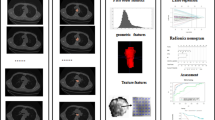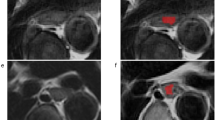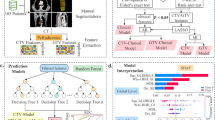Abstract
Objectives
To develop and validate an optimal model based on the 1-mm-isotropic-3D contrast-enhanced StarVIBE MRI sequence combined with clinical risk factors for predicting survival in patients with esophageal squamous cell carcinoma (ESCC).
Methods
Patients with ESCC at our institution from 2015 to 2017 participated in this retrospective study based on prospectively acquired data, and were randomly assigned to training and validation groups at a ratio of 7:3. Random survival forest (RSF) and variable hunting methods were used to screen for radiomics features and LASSO-Cox regression analysis was used to build three models, including clinical only, radiomics only and combined clinical and radiomics models, which were evaluated by concordance index (CI) and calibration curve. Nomograms and decision curve analysis (DCA) were used to display intuitive prediction information.
Results
Seven radiomics features were selected from 434 patients, combined with clinical features that were statistically significant to construct the predictive models of disease-free survival (DFS) and overall survival (OS). The combined model showed the highest performance in both training and validation groups for predicting DFS ([CI], 0.714, 0.729) and OS ([CI], 0.730, 0.712). DCA showed that the net benefit of the combined model and of the clinical model is significantly greater than that of the radiomics model alone at different threshold probabilities.
Conclusions
We demonstrated that a combined predictive model based on MR Rad-S and clinical risk factors had better predictive efficacy than the radiomics models alone for patients with ESCC.
Key Points
• Magnetic resonance–based radiomics features combined with clinical risk factors can predict survival in patients with ESCC.
• The radiomics nomogram can be used clinically to predict patient recurrence, DFS, and OS.
• Magnetic resonance imaging is highly reproducible in visualizing lesions and contouring the whole tumor.






Similar content being viewed by others
Abbreviations
- AIC:
-
Akaike Information Criterion
- AUC:
-
Area under curve
- CI:
-
Concordance index
- DCA:
-
Decision curve analysis
- DFS:
-
Disease-free survival
- EC:
-
Esophageal cancer
- ESCC:
-
Esophageal squamous cell carcinoma
- EUS:
-
Endoscopic ultrasound
- GLCM:
-
Gray-level co-occurrence matrix
- GLDM:
-
Gray-level dependence matrix
- GLRLM:
-
Gray-level run length matrix
- GLSZM:
-
Gray-level size zone matrix
- LASSO:
-
Least absolute shrinkage and selection operator
- NGTDM:
-
Neighboring gray tone difference matrix
- OS:
-
Overall survival
- pCR:
-
Pathological complete response
- Rad-S:
-
Radiomics scores
- RF:
-
Random forest
- ROC:
-
Receiver operating characteristic
- ROI:
-
Region of interest
- RSF:
-
Random survival forest
- SUR:
-
Standard uptake ratio
- SUV:
-
Standard uptake value
References
Sung H, Ferlay J, Siegel RL et al (2021) Global Cancer Statistics 2020: GLOBOCAN Estimates of incidence and mortality worldwide for 36 cancers in 185 countries. CA Cancer J Clin 71:209–249
Chen W, Zheng R, Baade PD et al (2016) Cancer statistics in China, 2015. CA Cancer J Clin 66:115–132
Arnold M, Soerjomataram I, Ferlay J, Forman D (2015) Global incidence of oesophageal cancer by histological subtype in 2012. Gut 64:381–387
Lagergren J, Smyth E, Cunningham D, Lagergren P (2017) Oesophageal cancer. Lancet 390:2383–2396
Hollis AC, Quinn LM, Hodson J et al (2017) Prognostic significance of tumor length in patients receiving esophagectomy for esophageal cancer. J Surg Oncol 116:1114–1122
Dexter SP, Sue-Ling H, McMahon MJ, Quirke P, Mapstone N, Martin IG (2001) Circumferential resection margin involvement: an independent predictor of survival following surgery for oesophageal cancer. Gut 48:667–670
Gao A, Wang L, Li J et al (2016) Prognostic value of perineural invasion in esophageal and esophagogastric junction carcinoma: a meta-analysis. Dis Markers 2016:7340180
Edge SB, Compton CC (2010) The American Joint Committee on Cancer: the 7th edition of the AJCC cancer staging manual and the future of TNM. Ann Surg Oncol 17:1471–1474
Deng J, Chu X, Ren Z, Wang B (2020) Relationship between T stage and survival in distantly metastatic esophageal cancer: a STROBE-compliant study. Medicine (Baltimore) 99:e20064
Butof R, Hofheinz F, Zophel K et al (2018) Prognostic value of SUR in patients with trimodality treatment of locally advanced esophageal carcinoma. J Nucl Med. https://doi.org/10.2967/jnumed.117.207670
Wani S, Das A, Rastogi A et al (2015) Endoscopic ultrasonography in esophageal cancer leads to improved survival rates: results from a population-based study. Cancer 121:194–201
Das A, Chak A, Sivak MV Jr, Payes J, Cooper GS (2006) Endoscopic ultrasonography and prognosis of esophageal cancer. Clin Gastroenterol Hepatol 4:695–700
Weber WA, Ott K (2004) Imaging of esophageal and gastric cancer. Semin Oncol 31:530–541
van Rossum PSN, van Lier A, Lips IM et al (2015) Imaging of oesophageal cancer with FDG-PET/CT and MRI. Clin Radiol 70:81–95
Kumar S, Rai R, Stemmer A et al (2017) Feasibility of free breathing Lung MRI for Radiotherapy using non-Cartesian k-space acquisition schemes. Br J Radiol 90:20170037
Li Y, Beck M, Passler T et al (2020) A FDG-PET radiomics signature detects esophageal squamous cell carcinoma patients who do not benefit from chemoradiation. Sci Rep 10:17671
Qiu Q, Duan J, Deng H et al (2020) Development and validation of a radiomics nomogram model for predicting postoperative recurrence in patients with esophageal squamous cell cancer who achieved pCR after neoadjuvant chemoradiotherapy followed by surgery. Front Oncol 10:1398
Qu J, Zhang H, Wang Z et al (2018) Comparison between free-breathing radial VIBE on 3-T MRI and endoscopic ultrasound for preoperative T staging of resectable oesophageal cancer, with histopathological correlation. Eur Radiol 28:780–787
Qu J, Shen C, Qin J et al (2019) The MR radiomic signature can predict preoperative lymph node metastasis in patients with esophageal cancer. Eur Radiol 29:906–914
Camp RL, Dolled-Filhart M, Rimm DL (2004) X-tile: a new bio-informatics tool for biomarker assessment and outcome-based cut-point optimization. Clin Cancer Res 10:7252–7259
van Griethuysen JJM, Fedorov A, Parmar C et al (2017) Computational radiomics system to decode the radiographic phenotype. Cancer Res 77:e104–e107
Chen X, Ishwaran H (2012) Random forests for genomic data analysis. Genomics 99:323–329
Tibshirani R (1997) The lasso method for variable selection in the Cox model. Stat Med 16:385–395
Bohanes P, Yang D, Chhibar RS et al (2012) Influence of sex on the survival of patients with esophageal cancer. J Clin Oncol 30:2265–2272
Xu H, Wu S, Luo H et al (2019) Prognostic value of tumor length and diameter for esophageal squamous cell cancer patients treated with definitive (chemo)radiotherapy: potential indicators for nonsurgical T staging. Cancer Medicine 8:6326–6334
Akutsu Y, Matsubara H (2011) The significance of lymph node status as a prognostic factor for esophageal cancer. Surg Today 41:1190–1195
Yang Z, He B, Zhuang X et al (2019) CT-based radiomic signatures for prediction of pathologic complete response in esophageal squamous cell carcinoma after neoadjuvant chemoradiotherapy. J Radiat Res 60:538–545
Jin X, Zheng X, Chen D et al (2019) Prediction of response after chemoradiation for esophageal cancer using a combination of dosimetry and CT radiomics. Eur Radiol 29:6080–6088
Luo HS, Huang SF, Xu HY, Li XY, Wu SX, Wu DH (2020) A nomogram based on pretreatment CT radiomics features for predicting complete response to chemoradiotherapy in patients with esophageal squamous cell cancer. Radiat Oncol 15:249
Mayerhoefer ME, Materka A, Langs G et al (2020) Introduction to radiomics. J Nucl Med 61:488–495
Rizzo S, Botta F, Raimondi S et al (2018) Radiomics: the facts and the challenges of image analysis. Eur Radiol Exp 2:36
Funding
This study has received funding by the Projects of the General Programs of the National Natural Science Foundation of China (No.81972802), Natural Science Foundation of Henan Province (No.182300410355), Henan Province Medical Science and Technology Research Program Provincial Department to jointly build key projects (No.SBGJ202002021), Special funding of the Henan Health Science and Technology Innovation Talent Project (No.YXKC2020011), Henan Province focuses on research and development and promotion (No.212102310133), Innovation Scientists and Technicians Troop Construction Projects of Henan Province (No.20160913), the Province-Ministry Co-construction Project of Health Committee of Henan Province (No.SB201901108) and Youth Talent Project of Henan Youth Health Science and Technology Innovation Foundation (No.YXKC2020022).
Author information
Authors and Affiliations
Corresponding author
Ethics declarations
Guarantor
The scientific guarantor of this publication is Jinrong Qu.
Conflict of interest
Two authors (Shaoyu Wang and Xu Yan) of this manuscript are employees of Siemens Healthineers. The remaining authors declare no relationships with any companies whose products or services may be related to the subject matter of the article.
Statistics and biometry
No complex statistical methods were necessary for this paper.
Informed consent
Written informed consent was waived by the Institutional Review Board.
Ethical approval
Institutional Review Board approval was obtained.
Methodology
• retrospective
• diagnostic or prognostic study
• performed at one institution
Additional information
Publisher’s note
Springer Nature remains neutral with regard to jurisdictional claims in published maps and institutional affiliations.
Supplementary Information
ESM 1
(DOCX 553 kb)
Rights and permissions
About this article
Cite this article
Chu, F., Liu, Y., Liu, Q. et al. Development and validation of MRI-based radiomics signatures models for prediction of disease-free survival and overall survival in patients with esophageal squamous cell carcinoma. Eur Radiol 32, 5930–5942 (2022). https://doi.org/10.1007/s00330-022-08776-6
Received:
Revised:
Accepted:
Published:
Issue Date:
DOI: https://doi.org/10.1007/s00330-022-08776-6




